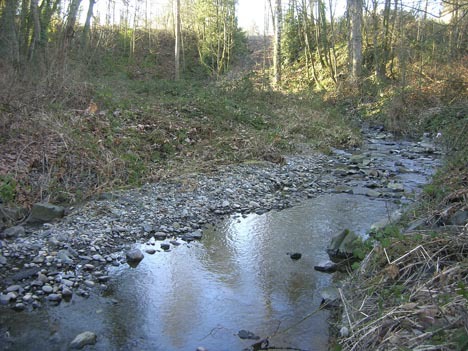A partnership that began 16 months ago between the City of Tacoma, the Puyallup Tribe, and a citizens group to create a stewardship plan for the First Creek watershed located on Tacoma’s East Side has improved public safety and restored, protected, and recognized the habitat’s cultural significance, according to partnership representatives.
On Nov. 18, 2008, Tacoma City Council adopted a resolution to create a stewardship plan to “assist the city in protecting infrastructure in the area, contribute to the city’s open space planning and environmental preservation efforts, recognize the cultural significance of the area, and allow the area to contribute to the quality of life in the area.”
The resolution grew out of the work of East Side resident Edwina Magrum, who contacted the City to address issues of drug use, prostitution, and other illegal activities in the heavily wooded area, which is surrounded by residential homes and the Emerald Queen Casino. Magrum reached City Hall at a time when City Manager Eric Anderson was starting an aggressive plan to reduce crime and eliminate blight. From there, a plan for First Creek (then named “T Street Gulch”) was born.
“The activity continues to be infectious,” said City staff liaison Alisa O’Hanlon during a meeting of Tacoma City Council’s environment and public works committee on March 24. O’Hanlon was joined by Magrum, East Side resident Dan Fear, and Puyallup Tribe representative David Whitehead to brief committee members on progress since the resolution was adopted.
According to Fear, 156 tons of trash have been removed from the First Creek area between East 32nd Street and East 34th Street by City employees and neighborhood volunteers. “It’s fun to be out there as a work crew leader because people see volunteers out there and stop by and say, ‘It looks great,'” said Fear. “Often they will give us their name and show some interest. But the long-term goal of this stewardship is to get citizens to appreciate this neglected greenbelt again.”
Magrum noted that 16 drug houses, two meth labs, and a marijuana operation near the First Creek area were shut down by Puyallup Tribe police officers and the Tacoma Police Department.
The project is guided by a stewardship plan centered on six key elements and their guiding principles: learn more about the history of First Creek; improve water quality for recreation, wildlife, and native plants; promote the area’s asset as a significant greenbelt in Tacoma; improve public safety; improve infrastructure such as roads, sewer lines, storm lines, and sidewalks; and increase public involvement and use of the area in order to keep it preserved.
First Creek volunteers noted many achievement in 2009, including the following: $15,000 was awarded to conduct stormwater monitoring by University of Washington Tacoma students; a survey of plant species was conducted; and crime in the area was reduced by 14.2 per cent over 2008.
The stewardship plan was first presented during a meeting of council’s environment and public works committee in November 2008.
“This is an opportunity to reclaim this area,” said O’Hanlon during that meeting. “It is an asset to the community.” O’Hanlon presented a resolution aimed to “make a statement” that the city and the tribe were committed to working together on long-term care of the area.
“We said let’s try to find some way to cut through red tape and clean up the debris,” said Public Works staffer Chris Ott in November 2008. He added that city officials shut down one methamphetamine lab and removed 81 tons of garbage during its first clean-up effort.
Whitehead provided some historical insight into the area during the Nov. 18 meeting. According to Whitehead, the First Creek Watershed, which consists of a series of gulches, was once a vital center for the tribe, and home to an Indian school, a major fishing village, and several tribal chiefs. He also said the area was originally named Satsop.
“This will aid in changing the perception of the area from a series of gulches to a community asset,” said Whitehead. He also commented that over time the area could provide a walking trail or bike path. “We believe it’s an excellent idea. It can also be a major step in improving government-to-government relations.”
Still, the is more work ahead.
In the long-term, First Creek stewards would like to install signage for the creek trail interpreting the Puyallup Tribe history; assess, map, and create a guidebook of medicinal plants in the area; replace invasive plants with native plants; improve the overall perception of the area as a safe place for recreational activities; and increase the frequency of community activities.
“While this is an exciting list and it is a work plan, our next horizon is figuring out how to create an environment that provides for spontaneous, regular, positive active use of the area,” said O’Hanlon during the March 24 meeting. “Right now, most of what happens in the creek is informal and organized by [Magrum, Fear, and Whitehead[. The next plateau we would like to take it to is to come up with what can we do to make sure people use the creek whenever they feel like it.”
“One of the things that I’m concerned with is the group consider the stewardship planning document as a living and active document that continues to map long-term goals, mid-range goals, but also continues to meet on a regular basis to maintain the high community energy and keep mapping and achieving short-term goals that demonstrate positive change and positive care for the east side,” said Whitehead.
On April 24, First Creek stewards will host a clean-up and native planting event between 10 a.m. and 2 p.m. For more information about the First Creek stewardship plan, visit http://www.firstcreekwatershed.blogspot.com/ .
– – – – – – – – – – – – – –
For earlier Tacoma Daily Index coverage of First Creek, click on the following:
New chapter for Tacoma’s First Creek watershed (11/19/08) — http://tacomadailyindex.com/portals-code/list.cgi?paper=88&cat=23&id=1421591&more=0








